[1]
Tassin,C.; Laroudie,F.; Pons,M.; Lelait, L.: Improvement of the Wear Resistance of 316L Stainless Steel by Laser Surface Alloying, Surface Coatings and Technology, 1996, 80 (1-2), pp.207-210.
DOI: 10.1016/0257-8972(95)02713-0
Google Scholar
[2]
Glaeser W.A.: Materials for Tribology, Tribology Series, 20, Elsevier, (1992).
Google Scholar
[3]
Mandl,S.; Gunzel, R.; Richiter,E.; Moller, W.: Nitriding of Austenitic Stainless Steels Using Plasma Immersion Ion Implantation, Surface Coatings and Technology, 1998, 100-101, pp.372-376.
DOI: 10.1016/s0257-8972(97)00651-8
Google Scholar
[4]
Sun, Y.; Bell, T.: Sliding Wear Characteristics of Low Temperature Plasma Nitrided 316 Austenitic Stainless Steel, Wear, 1998, 218 (1), pp.34-42.
DOI: 10.1016/s0043-1648(98)00199-9
Google Scholar
[5]
Jeong B.Y.; Kim, M.H.: Effects of Pulse Frequency and Temperature on the Nitride Layer and Surface Characteristics of Plasma NitridedStainless Steel, Surface Coatings and Technology, 2001, 137 (2-3), pp.249-254.
DOI: 10.1016/s0257-8972(00)01095-1
Google Scholar
[6]
Tian, X.; Fu, R. K. Y.; Wang, L.; Chu, P. K.: Oxygen-induced Nickel Segregation in Nitrogen Plasma Implanted AISI 304 Stainless Steel. Materials Science and Engineering: A, 2001, 316 (1-2), pp.200-204.
DOI: 10.1016/s0921-5093(01)01245-x
Google Scholar
[7]
Singh,V.; Marchev,K.; Cooper C.V.; Meletis, E.I.: Intensified Plasma-Assisted Nitriding of AISI 316L Stainless Steel, Surface Coatings and Technology, 2002, 160 (2-3), pp.249-258.
DOI: 10.1016/s0257-8972(02)00403-6
Google Scholar
[8]
Liang, W.: Surface Modification of AISI 304 Austenitic Stainless Steel by Plasma Nitriding, Applied Surface Science, 2003, 211 (1-4), pp.308-314.
DOI: 10.1016/s0169-4332(03)00260-5
Google Scholar
[9]
Xia, Y.; Hu, J.; Zhou, F.; Lin, Y.; Qiao, Y.; Xu, T.: Friction and Wear Behavior of Plasma Nitrided 1Cr18Ni9Ti Austenitic Stainless Steel under Lubrication Condition, Materials Science and Engineering: A, 2005, 402 (1-2), pp.135-141.
DOI: 10.1016/j.msea.2005.04.012
Google Scholar
[10]
Li,G. J.; Peng, Q.; Li, C.; Wang,Y.; Gao,J.; Chen, S. Y.; Wang,J.; Shen, B. L.: Effect of DC Plasma Nitriding Temperature on Microstructure and Dry-Sliding Wear Properties of 316L Stainless Steel, Surface Coatings and Technology, 2008, 202 (12), pp.2749-2754.
DOI: 10.1016/j.surfcoat.2007.10.002
Google Scholar
[11]
Majumdar, J. D.; Kumar, A.; Li, L.: Direct Laser Cladding of SiCDispersed AISI 316L Stainless Steel, Tribology International, 2009, 42 (5), pp.750-753.
DOI: 10.1016/j.triboint.2008.10.016
Google Scholar
[12]
Xu, P.; Lin, C. H.; Zhou, C. Y.; Yi, X. P.: Wear and Corrosion Resistance of Laser Cladding AISI 304 Stainless Steel/Al2O3Composite Coatings, In Press.
DOI: 10.1016/j.surfcoat.2013.10.028
Google Scholar
[13]
Sexton,L.; Lavin,S.; Byrne,G.; Kennedy,A.: Laser cladding of aerospace materials, Journal of Materials Processing Technology, 2002, 122 (1), pp.63-68.
DOI: 10.1016/s0924-0136(01)01121-9
Google Scholar
[14]
Cheng, F. T.; Lo, K. H.; Man, H. C.: A Preliminary Study of Laser Cladding of AISI 316 Stainless Steel Using Preplaced NiTiWire, Materials Science and Engineering: A, 2004, 380 (1-2), pp.20-29.
DOI: 10.1016/j.msea.2004.01.056
Google Scholar
[15]
Chiu, K. Y.; Cheng, F. T.; Man, H. C.: Laser Cladding of Austenitic Stainless Steel Using NiTiStrips for Resisting Cavitation Erosion, Materials Science and Engineering: A, 2005, 402 (1-2), pp.126-134.
DOI: 10.1016/j.msea.2005.04.013
Google Scholar
[16]
Cai, L.; Zhang, Y.; Shi, L.: Microstructure and Formation Mechanism of Titanium Matrix Composites Coating on Ti-6Al-4V by Laser Cladding, Rare Metals, 2007, 26 (4), pp.342-346.
DOI: 10.1016/s1001-0521(07)60226-5
Google Scholar
[17]
Lin, Y. C.; Chen,H. M.; Chen, Y. C.: Analysis of Microstructure and Wear Performance of SiCClad Layer on SKD61 Die Steel after Gas Tungsten Arc Welding, Materials and Design, 2013, 47, pp.828-835.
DOI: 10.1016/j.matdes.2013.01.007
Google Scholar


